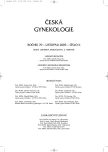Single Embryo Transfer Does not Compromise the Pregnancy Rate in Patients with Good IVF/ICSI Prognosis
Transfer jednoho embrya u pacientek s dobrou prognózou léčby pomocí IVF/ICSI nesnižuje pravděpodobnost otěhotnění
Cíl práce:
Dvoučetná gravidita je v současné době vnímána jako suboptimální výsledek léčby pomocí IVF/ICSI. Nejlepší cestou, jak snížit zastoupení dvojčat, je snížit počet transferovaných embryí ze dvou (double embryo transfer - DET) na jediné (single embryo transfer – SET). Cílem naší studie je srovnat úspěšnost SET a DET v předem definované skupině pacientek s dobrou prognózou léčby pomocí IVF/ICSI.
Typ studie:
prospektivní klinická observační studie
Název a sídlo pracoviště:
Gynekologicko-porodnická klinika 1. LF UK a VFN.
Metodika:
Od 1. 1. 2003 do 31. 12. 2004 jsme nabídli SET nebo DET 331 párům splňujícím vstupní kritéria: věk ženy do 35 let, získání 3 nebo více kvalitních embryí 4. den kultivace. SET si vybralo 57 párů (17,2 %), DET 274 párů (82,8 %). Srovnávali jsme pravděpodobnost klinické gravidity ve skupině SET a DET. Pro statistické zpracování jsme použili Studentův t-test a F test na hladině významnosti p<0,05.
Výsledky:
SET byl proveden u 57 žen (17,2 %), DET u 274 žen (82,8 %). Mezi sledovanými skupinami nebyly signifikantní rozdíly ve věku, počtu získaných oocytů a celkovém počtu transferovaných embryí. Ve skupině SET bylo prokázáno 30 klinických těhotenství (52,6 %). Ve skupině pacientek DET bylo prokázáno 151 klinických těhotenství (55,1 %).Tento rozdíl nebyl statisticky významný. Statisticky vysoce významné rozdíly (p<0,0001) byly nalezeny ve výskytu dvojčat. Ve skupině pacientek SET nebyla zachycena žádná dvoučetná gravidita (0,0 %), ve skupině DET bylo 57 dvojčat (37,7 %) a jedna trojčetná gravidita (0,4 %).
Závěr:
Transfer jednoho embrya ve skupině pacientek s dobrou prognózou nesnižuje významně pravděpodobnost otěhotnění, ale oproti skupině s transferem dvou embryí významně snižuje výskyt dvojčat.
Klíčová slova:
transfer jednoho embrya, těhotenství, dvojčata, IVF/ICSI
Authors:
D. Koryntová; Martina Moosová; K. Řežábek; I. Pavelková; M. Mára
Authors‘ workplace:
MUDr. A. Martan, DrSc.
; Centrum asistované reprodukce, Gynekologicko-porodnická klinika VFN a 1. LF UK, Praha, přednosta prof.
Published in:
Ceska Gynekol 2005; 70(6): 435-439
Category:
Original Article
Overview
Objective:
Twin pregnancy is perceived as a suboptimal result of an IVF/ICSI cycle. The most effective way to reduce the number of twins in IVF/ICSI program is a single embryo transfer. The aim of our study was to compare the efficiency of elective single embryo transfer (eSET) and double embryo transfer (DET) in the couples with a very good prognosis of IVF/ICSI.
Design:
Prospective case observational study.
Settings:
Department of Obstetrics and Gynecology, Charles University, 1nd Medical Faculty and General Teaching Hospital, Prague, Czech republic.
Methods:
A prospective study focused on eSET was performed between 1. 1. 2003 and 31. 12. 2004. We offered eSET or eDET to 331 IVF/ICSI couples who met the following inclusion criteria: age of the women <35 years, 3 and more top quality embryos on day 4 after oocyte pick up. Fifty seven (17.2%) couples have chosen eSET and 274 (82.7%) couples preferred eDET. We compared clinical pregnancy rates in two groups of patients: In a group of patients who have chosen eSET versus patients who have preferred double embryo transfer (eDET). Student’s t-test and F test were used to compare both groups.
Results:
Patients in both groups were not significantly different in age, number of oocytes retrieved and total number of quality embryos. In the eSET group, we achieved 30 clinical pregnancies and the pregnancy rate (PR) was 52.6%. In the eDET group, 151 clinical pregnancies were observed and the PR was 55.1%. Although the pregnancy rate in the eDET group was higher than in the eSET group, the difference between the two groups was not statistically significant. We have not observed any twin pregnancy (0.0%) in the eSET group while 57 (37.7%) twin pregnancies and 1 pregnancy with 3 embryos (0.4%) have been observed in the eDETgroup. This difference is statistically significant (P<0.00001).
Conclusion:
In the group with a very good IVF/ICSI prognosis (women <35 years, 3 and more top quality embryos on day 4 after oocyte pick up), eSET did not significantly decrease the chance to achieve clinical pregnancy in comparison with DET. eSET seems to be a very efficient option to reduce the rate of twin pregnancy without compromising the pregnancy rate and should be recommended to these patients.
Key words:
single embryo transfer, pregnancy, twins, IVF/ICSI
Labels
Paediatric gynaecology Gynaecology and obstetrics Reproduction medicineArticle was published in
Czech Gynaecology

2005 Issue 6
Most read in this issue
- Rescue Cerclage in the Treatment of Cervical Insufficiency
- Obstetric Operation, Instrumental Delivery and 3rd Degree Perineal Tear and Anal Incontinence
- Plastic Adjustment in Hypertrophy of Labia Minora
- Single Embryo Transfer Does not Compromise the Pregnancy Rate in Patients with Good IVF/ICSI Prognosis
